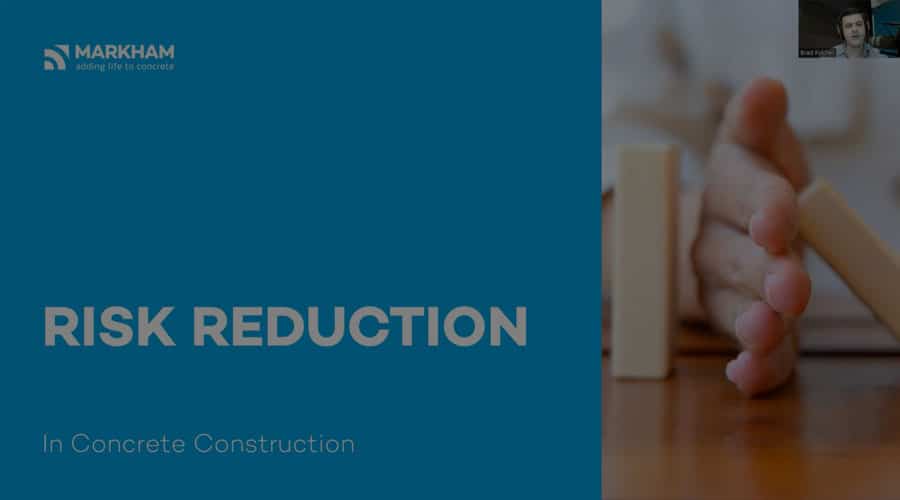Risk Reduction In Concrete Construction

Risk Reduction In Concrete Construction
Webinar Show Notes
Concrete – Waterproofing – Durability invisible-strength.com/webinars/concrete-waterproofing-durability
Problem Concrete markhamglobal.com/problem-concrete
Learning Outcomes
- Discussion on concrete construction industry risks
- Reduce risk during the construction phase
- Reduce risk by proactive maintenance
BRAD: Good morning, good afternoon, wherever you might be Zoomed in from. Welcome to this week’s MARKHAM webinar. Today we’re going to look at risk reduction in concrete construction. Have you guys ever had issues on your sites with quality control, or build quality, that’s opened you up for more risks or more frustration onsite? Well, today we’re going to look into some of the things that we see on building sites, and some of the ways that we can help out with mitigating these risks.
So please welcome Doug Hamlin. Doug Hamlin is Zoomed in from Auckland, New Zealand. He’s been with the company for a long time, got a lot of experience with this subject. So feel free to hit him up with any questions you might have. Myself, Brad Fulcher, I am Zoomed in from Sydney, Australia. I predominantly look after the sunny state of Queensland.
So down the bottom, as you’d be well aware, there’s a Q&A button. Please put in any questions you have during this short presentation. We will have time at the end to go through these questions and hopefully answer them and help you guys out with any needs on your projects.
Just before we kick off, we’ll just do a quick welcome poll. If you can share a little bit about who you are, what your background is, that’ll help us immensely. Thank you. Just give you a few more seconds to get those responses in.
All right, great. There’s just a few more people jumping on board. Thanks, everyone, for filling out that poll. It looks like a lot of you are interested in new innovations and new technologies. So we’ll definitely dive in into that a bit later on, which is great.
So first of all, some of the learning outcomes from this webinar. So we’re going to talk about the concrete construction and the risk involved, some of the things that we see. We’re going to look at how to reduce these risks in the construction phase, and then we’re also going to have a look at maintenance. So the long-term maintenance and being proactive about that as well, which is an important thing for reducing the risk that way.
So some of the modern construction challenges that we see, and no doubt you guys see as well, onsite. So these are very common; most of them have been around for a while. But in this current situation at the moment we find ourselves in, they have been sort of highlighted if you like. The first one is schedules. So we’ve really seen a lot of these getting tighter and tighter. Lost time during the COVID period, so the last couple years, is obviously not helping that. So a major thing people are looking at is how can we be faster, smarter, those sorts of things.
Then we’ve got the material costs and the client’s cost expectations. So this is mainly around builders in a contract versus their material costs going up, as you know, so a major consideration. Then labour shortages as well. So being able to get the right labour, with the right qualifications and the right amount of experience, those sorts of things, it’s becoming harder and harder as the labour pool dries up.
So this does result in some quality control challenges, unfortunately. So we see a result, for instance, if we have a shortage of a particular material, this can be substituted out for a different material, but it doesn’t always mean you’ll get the same result. So these sort of things, while we can’t do a lot about – the building has to move forward and we have to do what we can to keep this moving – it does pay to do a bit of research into that. Things like labour as well, trying to get the right qualifications of people that are on there. This can be a prime result that the building may not end up to be designed as it was at the start. So something we can look into.
Over to you, Doug, for a look into how this affects concrete.
DOUG: Thanks, Brad. That’s a good overview there. So obviously, we at MARKHAM, everything we do revolves around concrete; we couldn’t really do a webinar without discussing concrete. So in terms of structural concrete, obviously, it’s a very key material, and still used as a very, very staple building construction material. But what’s often connected with concrete when things go wrong is the visual effects; so if the concrete pour is honeycombed or cracked, or whatever it maybe. Often, there’s a lot of complaints about the visuals, and how can we get them looking right. But what’s not always thought about or connected is the long-term durability. So when a concrete cracks, over time, it can let the contaminants in through that concrete. Now, normally, there’s enough cover concrete covering the reinforcing steel to protect it against those. But if we’ve got poor concrete quality, that process or that deterioration process speeds up essentially, and can lead to premature deterioration.
Some of the other issues we see come about due to poor curing quality. So more often, or far too often, we see that curing is left out or not given full consideration. This is not just us as product suppliers saying this, this is in all the engineering handbooks on concrete, that securing a concrete is very, very important to the long-term quality of that concrete. It basically is because if you don’t get that concrete hydrated properly, you can lose out on strength, obviously. But it can also result in shrinkage cracking, or excessive shrinkage cracking, that type of thing.
Now, another area that we see quite often is congested reinforcing, so the likes of pile cages or column reinforcing cages. They’re very congested, and then when the concrete is poured in there, they can move. It only has to move a few millimetres, and that results in a lowered cover to the reinforcing steel. Now, just on that, on the cover concrete, its main purpose is to protect that reinforcing steel from deterioration or from rusting, which obviously leads to spalling, that type of thing. So if that cover concrete is compromised and it’s not remediated, that can lead to long-term, or shortened service life, if you like, of the concrete.
Let’s move on to the next one. The other area we see is, I guess you could say what needs more input in construction planning is the construction joint layout, doing what we can to mitigate random cracking on concrete slabs. So whether that’s by a detailed sawcut plan on a slab pour before the pour has even happened, or being smart around things like re-entrant corners around columns, that type of thing. Because what happens if you don’t do proper planning around this area, is you end up with a random cracking pattern, like a map cracking pattern, and that’s much harder to remediate. It doesn’t look good visually, and it’s much better to have a planned nice straight line in a sawcut or a construction joint that you can, for one, seal properly. It’s much easier to seal something that’s in a straight line versus a crack that follows a random pattern across the slab.
So on that, just one more point with cracking, again. I mentioned earlier, and I really want to touch on it, is if you do leave a concrete slab with cracks in it, that fast-tracks that contamination, or the pathways for contamination, to get into the concrete, and it starts that corrosion process of the reinforcing steel a lot quicker. I mean, you see it a lot on construction sites, rust stain coming out of a construction joint or a crack or something like that, and often that’s happening long before the building is actually even finished.
So if we can move on to the next slide there. I think that’s your one, Brad.
BRAD: Yes. Thanks for that, Doug. So there are a couple of more, other areas that we do see challenges as well in the industry. One of those is waterproofing. So just a quick overview, or a quick stat there. It can cost as little as 3% of the project, but it can be up to 80% of the remediation costs. So when we we’re thinking waterproofing, saving that one day or a couple of dollars onsite can actually have a big effect further down the track. So it’s important that we do get this right.
Another thing we see in the industry more and more is a lot of new ideas coming through, and new ideas bring new challenges. So a lot of these are around sustainability, the environment and environmentally-friendly products and systems, which is great, it’s good news. But we do need to be careful, we do need to be making sure we’re really looking into these ideas and these systems, making sure they are fit for purpose, and making sure that end results are same. So as these are new ideas, we’re still learning about the longer-term impacts, which can change over time.
Then there’s maintenance. So we’re seeing this more and more as costs are getting tighter, maintenance, or ongoing maintenance, is one of the first things people seem to drop off on. So rather than inspecting a structure twice, or whatever their normal pattern is, twice a year, they’re doing it once a year, things like that, trying to save those dollars there. But it does mean you’ve got to pay those dollars somewhere. So whether you save it now or spend it later, it doesn’t change.
One of the things that we often talk about is De Sitter’s Law of Fives. So this goes through the process of getting in early, finding those issues or looking for signs that issues could be happening early, coming up with the system to remediate them. Then at the back-end of the project, or at the back-end of the lifespan, we are saving that money there. So it’s a fairly simple idea. But it does show that by getting in early, we can really do a lot to save money, save our carbon footprint and the rebuild costs, by doing that extra due diligence at the early stage.
DOUG: Also, on that, De Sitter’s Law of Fives, it may not necessarily be spending extra funds. It might be just having a bit more planning, getting everyone together to discuss and plan before a concrete pour, or whatever that maybe, or put in a plan for maintenance. Do you think?
BRAD: Yes, 100% true. So whether it’s time, money, or whatever resource that you’re putting in at the start, you can save that resource at the end. Doug, do you want take us through some of the systems we use?
DOUG: Yes. So we obviously want to touch on how we can assist with reducing this risk in concrete. So the main area that we get involved in is with what we call concrete hydrogels. Now, in concrete, as it’s formed, so when you place concrete, there’s a certain amount of water that’s used to mix the concrete that forces its way out of the concrete. So it evaporates essentially, and leaves pathways through the concrete matrix. Now what the hydrogel does, whether that’s mixed into the concrete or whether that’s spray-applied, is it reacts with the moisture and the alkalinity in those porosities in forms of gel, and stops that moisture movement, if you like, or stops that contamination, or stops those pathways for contamination from being able to transport them through the concrete. So these blue lines, they used to be able to transport moisture and can no longer, as they’re essentially locked up in the hydrogel.
With the hydrogels we work with, they are colloidal silica hydrogels, so we’re not putting anything foreign or new into concrete. Silica has been in concrete since time was, or since concrete was used. So it’s very safe in terms of compatibility, in terms of strength and long term-effects, and contributes to extending that life of the concrete. Go to the next one there, Brendan.
BRAD: Quick reminder to keep putting those questions down at the bottom, we’ll get to them at the end. Thanks, all.
DOUG: Thanks, Brad. So another area we can assist in is waterproofing. So Brad mentioned at the start, or probably through the webinar there, that waterproofing accounts for 80% of the issues relating to building defects. That’s a huge cost. I mean, you don’t have to go to many days to see another article in the paper about some leaky building, which is not good. So our system looks at it as a three-part system that we’re involved in from right the way through. So that’s from design and sitting down with the consultants, right the way through to the onsite installation of the product or that system. That includes an admixture inside the concrete, it includes a spray-applied treatment as a backup to the surface. Then most importantly, the joint layouts and detailing. So mitigating that cracking risk and making sure that those joints are waterproof, it’s probably the most common area that causes issues with waterproofing. Next slide.
Yes, and just lastly, probably the main thing, which you don’t always see it, it’s not something physical, or not tangible, but it is the end-to-end service that MARKHAM provides. I mentioned from design all the way through to onsite, that’s something that we’re really proud of and we really push. So making sure that only approved applicators can put our products on onsite, making sure that the joint detailing and everything is signed off. Then at the end of the project, we give you a performance-based warranty, that says that we’re happy with the concrete quality, we’re happy with the waterproofing detailing, and we can provide you with a meaningful performance warranty for whatever the agreed warranty term is. So that fits in with your asset management, and pulls or takes that risk away from you as a consultant asset owner, whatever it may be.
So that brings us to the end of our webinar today. Appreciate any questions, see there’s some questions come up there. If there’s any further ones, email Brad and myself, our email addresses are on the screen there. Or otherwise, just jump on our website when the time arises that you need to talk to us, and we can get in touch. Brad, do you want to look at that first question?
BRAD: Great. Thanks, Doug. It’s actually probably one more for you, you talked about it earlier. You mentioned low cover issues, tell us more about fixing that problem.
DOUG: Yes, sure thing. So low cover is something that is often checked in the construction process. Obviously, it’s not nice topic that anyone really likes to talk about. But basically, what we can do is spray-apply on some of the hydrogel, there’s a couple of different options there. It increases the durability of that cover concrete by essentially waterproofing it. So in terms of permeability of the concrete and in terms of durability, a concrete that may have leak-through, just for number’s sake, say, 100mm of water over a certain time period, only leaks through 50mm. So the permeability is effectively halved. Flipping that around the other way, if you say you had 25mm of cover and you needed 35mm, once it’s treated, the equivalent cover becomes 50mm of concrete. Is there any more on that one, Brad?
BRAD: No, that’s good. So essentially, it’s making the cover do the job that it was meant to do in the first place, which is protecting that reinforcing from the elements. Another question. How do hydrogel treatments delay construction schedules, or do they? Is there any significant downtime after application?
I’ll start off on this one, and Doug can chip in. So depending on which or what treatment we’re doing, it can affect it. But in the main, there is very, very limited downtime. So most of the hydrogel treatments go down a cure stage. As Doug mentioned earlier, part of our approach is that we do the installation as well, which means we’ve got a very flexible team. Essentially, once the concrete is finished onsite, we’ll be in there at the afternoon and get it applied that afternoon. The next day, when you come back onsite, there’s difference that you need to do as far as treating slab, it’s ready to go as per normal. In retrofit, same situation, we’ll get access to the concrete, for example, for low cover area. The applicators obviously need access to the concrete. We’ll spray our treatments, and an hour after we’ve sprayed, you can just carry on as normal. So very limited downtime, and very low cure time as well.
DOUG: Another one there, Brad, I think you might as well carry on. How do you manage the risk with compatibility with other products or other systems in the concrete, that get applied to concrete I guess they’re meaning there?
BRAD: Yes, good question. So it is important that we do make sure anything we’re doing is compatible. If it’s not looked into, it can cause big issues further down the track. So the first thing or the good news is that the AQURON hydrogel treatments are compatible with basically anything that’s designed to be used on bare concrete. When Doug was going through that, he mentioned we don’t add anything foreign to the concrete, and we’re also penetrating, so we don’t change the surface of the concrete at all. So all your typical epoxies, line markings, or silicones, things like that, if you’re waterproofing around those sorts of areas, is all compatible. It is very important that you do your research on any products you’re using, making sure that they’re not going to trip you up or slow you down later down in other parts of the construction.
DOUG: The classic areas there is, like a curing compound. Obviously looks cheap on pour days, but it looks very expensive when you get to that floorcovering time and it needs to be removed prior to floor coverings and things being put down. It catches too many people out, it’s almost painful to get those calls asking if we can help.
BRAD: Yes, a very simple and just a quick look into it at that time can save them. So you’re probably talking a about 10-minute research, which can save them $20 per square metre grind. There’s another one on there about the warranties. What sort of warranties are offered for the different treatments?
DOUG: Yes. It is a performance warranty, so I’d say offered on a square metre result if you like, and it varies for each system or product that we put forward or install. Generally on a new project, we match the design life, if we can get involvement in the design and the detailing, that sort of thing. Say, if it’s a retro-treating situation or remediation, we may pull that back a bit, obviously based on the condition or the structure and the environment that it’s in, that type of thing. But it is always a result that’s warranted. If it’s not performing as it is, we’ll get in there and fix it up, rather than just supply you more products or replacement product, that type of thing.
BRAD: It’s got to be measurable as well, doesn’t it? So when we’re talking warranties, we have a benchmark or something that we’re actively comparing it to.
DOUG: Yes. All right, I don’t think there’s any more questions coming there, Brad.
BRAD: No, that’s it for the moment.
DOUG: Hopefully, it’s been helpful for the audience there.
BRAD: Thank you everyone for joining. Please feel free to reach out, our emails are up there, or just phone, or website, if you do have any further questions.
DOUG: Cool. See you later.
More about MARKHAM
MARKHAM are dedicated to providing innovations for concrete and construction. Focusing on concrete waterproofing solutions, penetrating concrete sealers and durability treatments concrete.
Newsletter
Sign up for email updates on the latest collections, campaigns and videos.




